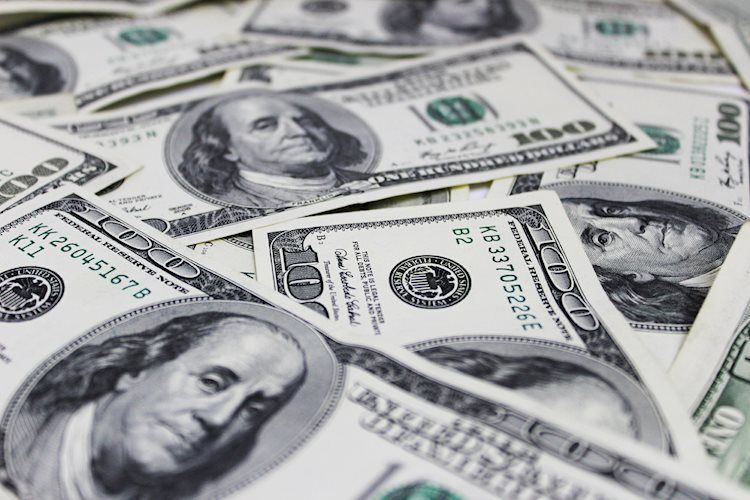- DXY Index trades with mild losses at 103.25.
- The US reported mixed housing market data on Monday.
- All eyes are on PCE data from October to be reported on Thursday.
The US Dollar (USD) Index hovers at 103.25 with nearly 0.15% losses. The Greenback remains vulnerable due to dovish speculation on the Federal Reserve’s future movements, and markets brace for Thursday’s Personal Consumption Expenditures (PCE) figures, the Federal Reserve’s (Fed) preferred inflation gauge. On the data front, October’s reports of New Home Sales and Building Permits, released during the session, did not impact the USD’s dynamics.
Amid cooling labour market performance and inflation in the United States economy, the markets are betting on a dovish Federal Reserve, which has weakened the US Dollar. Before the December meeting, where markets will get clear guidance, investors will get October’s PCE figures, an additional jobs report, and the November Consumer Price Index (CPI). These releases will likely set the pace for the next movements of the US Dollar..
Daily Market Movers: US Dollar trades weak; markets await guidance on October PCE inflation figures
- The US Dollar navigates a neutral range, susceptible to looming PCE inflation figures and dovish bets on the Fed.
- On the data front, October registered a downturn in New Home Sales, coming short of the expected 725K with an actual figure of 679K, as reported by the US Census Bureau.
- A bright spot in October was the Building Permits figure, which exceeded both previous and predicted numbers at 1.498 million.
- The tables have turned for US bond yields, which are witnessing a downturn to start the week with 2-year, 5-year and 10-year yields standing at 4.92%, 4.44% and 4.42%, respectively, now limiting the USD’s advance.
- According to the CME FedWatch Tool, markets are pricing in a no-hike at the December meeting. Rate swaps futures see rate cuts in mid-2024.
Technical Analysis: US Dollar faces headwinds as bearish trend persists
The Relative Strength Index (RSI) indicates that the US Dollar is trading near oversold territory. This suggests that the selling pressure is excessive, hence the prevailing bearish momentum. Additionally, the Moving Average Convergence Divergence (MACD) histogram shows the MACD line is below the signal line, providing evidence of a potential bearish reversal.
Adding to the bearish case, the currency pair remains under the shield of its 20, 100 and 200-day Simple Moving Averages (SMAs), indicating that bulls are having a tough time wresting control from bears. With the pair beneath the SMAs, a continuation of the downtrend could be on the cards.
Support levels: 103.20, 103.10, 103.00.
Resistance levels: 103.60 (200-day SMA), 104.00, 104.20 (100-day SMA)
US Dollar FAQs
The US Dollar (USD) is the official currency of the United States of America, and the ‘de facto’ currency of a significant number of other countries where it is found in circulation alongside local notes. It is the most heavily traded currency in the world, accounting for over 88% of all global foreign exchange turnover, or an average of $6.6 trillion in transactions per day, according to data from 2022.
Following the second world war, the USD took over from the British Pound as the world’s reserve currency. For most of its history, the US Dollar was backed by Gold, until the Bretton Woods Agreement in 1971 when the Gold Standard went away.
The most important single factor impacting on the value of the US Dollar is monetary policy, which is shaped by the Federal Reserve (Fed). The Fed has two mandates: to achieve price stability (control inflation) and foster full employment. Its primary tool to achieve these two goals is by adjusting interest rates.
When prices are rising too quickly and inflation is above the Fed’s 2% target, the Fed will raise rates, which helps the USD value. When inflation falls below 2% or the Unemployment Rate is too high, the Fed may lower interest rates, which weighs on the Greenback.
In extreme situations, the Federal Reserve can also print more Dollars and enact quantitative easing (QE). QE is the process by which the Fed substantially increases the flow of credit in a stuck financial system.
It is a non-standard policy measure used when credit has dried up because banks will not lend to each other (out of the fear of counterparty default). It is a last resort when simply lowering interest rates is unlikely to achieve the necessary result. It was the Fed’s weapon of choice to combat the credit crunch that occurred during the Great Financial Crisis in 2008. It involves the Fed printing more Dollars and using them to buy US government bonds predominantly from financial institutions. QE usually leads to a weaker US Dollar.
Quantitative tightening (QT) is the reverse process whereby the Federal Reserve stops buying bonds from financial institutions and does not reinvest the principal from the bonds it holds maturing in new purchases. It is usually positive for the US Dollar.
